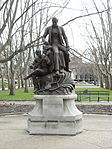Log Cabin (University of Pittsburgh)

The Log Cabin at the University of Pittsburgh, located near Forbes Avenue, in Pittsburgh, Pennsylvania adjacent to the school's Cathedral of Learning, serves as a landmark that symbolizes the university's origins on the 18th Century western frontier of the early United States. The current log cabin, estimated to date from the 1820s to 1830s, was reconstructed on the university's campus for its bicentennial celebration in order to represent Pitt's original log structure that served the institution through the school's founding in 1787 to the construction of a brick building sometime in the 1790s. The Log Cabin often appears in images and promotional material, particularly when relating to the history of the university.
Excerpt from the Wikipedia article Log Cabin (University of Pittsburgh) (License: CC BY-SA 3.0, Authors, Images).Log Cabin (University of Pittsburgh)
Forbes Avenue, Pittsburgh
Geographical coordinates (GPS) Address External links Nearby Places Show on map
Geographical coordinates (GPS)
| Latitude | Longitude |
|---|---|
| N 40.44389 ° | E -79.95198 ° |
Address
Log Cabin
Forbes Avenue
15213 Pittsburgh
Pennsylvania, United States
Open on Google Maps








